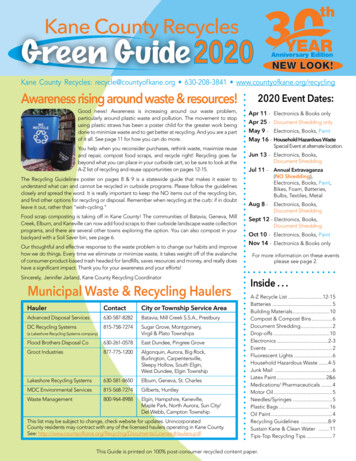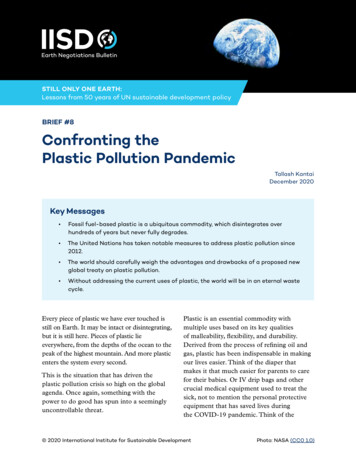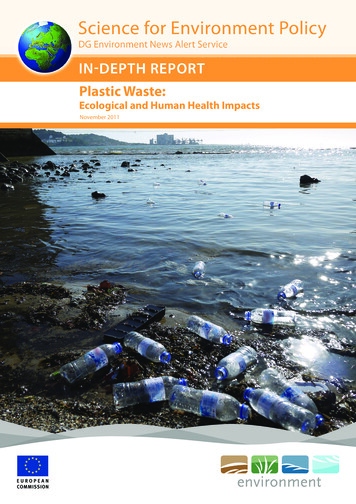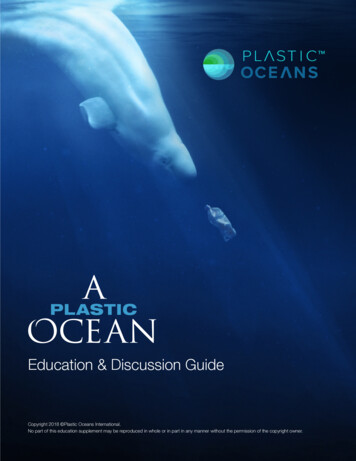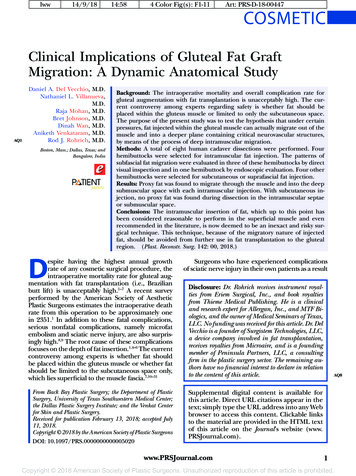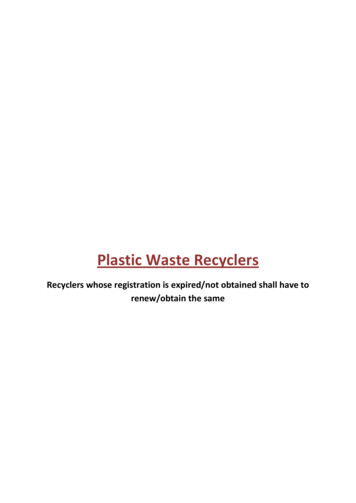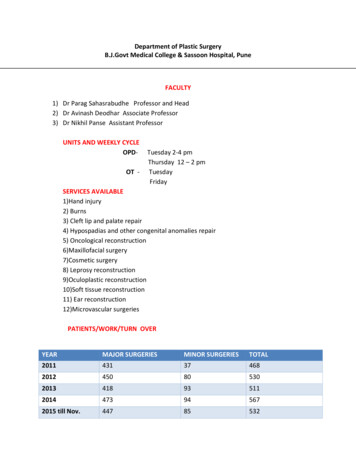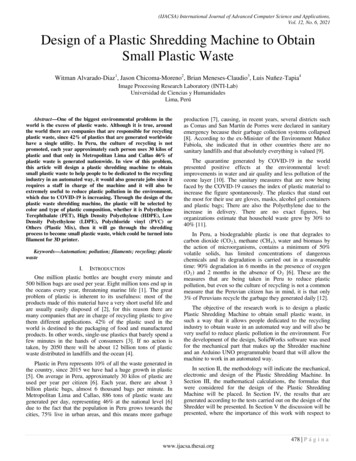
Transcription
(IJACSA) International Journal of Advanced Computer Science and Applications,Vol. 12, No. 6, 2021Design of a Plastic Shredding Machine to ObtainSmall Plastic WasteWitman Alvarado-Diaz1, Jason Chicoma-Moreno2, Brian Meneses-Claudio3, Luis Nuñez-Tapia4Image Processing Research Laboratory (INTI-Lab)Universidad de Ciencias y HumanidadesLima, PerúAbstract—One of the biggest environmental problems in theworld is the excess of plastic waste. Although it is true, aroundthe world there are companies that are responsible for recyclingplastic waste, since 42% of plastics that are generated worldwidehave a single utility. In Peru, the culture of recycling is notpromoted, each year approximately each person uses 30 kilos ofplastic and that only in Metropolitan Lima and Callao 46% ofplastic waste is generated nationwide. In view of this problem,this article will design a plastic shredding machine to obtainsmall plastic waste to help people to be dedicated to the recyclingindustry in an automated way, it would also generate jobs since itrequires a staff in charge of the machine and it will also beextremely useful to reduce plastic pollution in the environment,which due to COVID-19 is increasing. Through the design of theplastic waste shredding machine, the plastic will be selected bycolor and type of plastic composition, whether it is PolyethyleneTerephthalate (PET), High Density Polyethylene (HDPE), LowDensity Polyethylene (LDPE), Polychloride vinyl (PVC) orOthers (Plastic Mix), then it will go through the shreddingprocess to become small plastic waste, which could be turned intofilament for 3D printer.Keywords—Automation; pollution; filaments; recycling; plasticwasteI.INTRODUCTIONOne million plastic bottles are bought every minute and500 billion bags are used per year. Eight million tons end up inthe oceans every year, threatening marine life [1]. The greatproblem of plastic is inherent to its usefulness: most of theproducts made of this material have a very short useful life andare usually easily disposed of [2], for this reason there aremany companies that are in charge of recycling plastic to givethem different applications. 42% of the plastic used in theworld is destined to the packaging of food and manufacturedproducts. In other words, single-use plastics that barely spend afew minutes in the hands of consumers [3]. If no action istaken, by 2050 there will be about 12 billion tons of plasticwaste distributed in landfills and the ocean [4].Plastic in Peru represents 10% of all the waste generated inthe country, since 2015 we have had a huge growth in plastic[5]. On average in Peru, approximately 30 kilos of plastic areused per year per citizen [6]. Each year, there are about 3billion plastic bags, almost 6 thousand bags per minute. InMetropolitan Lima and Callao, 886 tons of plastic waste aregenerated per day, representing 46% at the national level [6]due to the fact that the population in Peru grows towards thecities, 75% live in urban areas, and this means more garbageproduction [7], causing, in recent years, several districts suchas Comas and San Martín de Porres were declared in sanitaryemergency because their garbage collection systems collapsed[8]. According to the ex-Minister of the Environment MuñozFabiola, she indicated that in other countries there are nosanitary landfills and that absolutely everything is valued [9].The quarantine generated by COVID-19 in the worldpresented positive effects at the environmental level:improvements in water and air quality and less pollution of theozone layer [10]. The sanitary measures that are now beingfaced by the COVID-19 causes the index of plastic material toincrease the figure spontaneously. The plastics that stand outthe most for their use are gloves, masks, alcohol gel containersand plastic bags; There are also the Polyethylene due to theincrease in delivery. There are no exact figures, butorganizations estimate that household waste grew by 30% to40% [11].In Peru, a biodegradable plastic is one that degrades tocarbon dioxide (CO 2 ), methane (CH 4 ), water and biomass bythe action of microorganisms, contains a minimum of 50%volatile solids, has limited concentrations of dangerouschemicals and its degradation is carried out in a reasonabletime: 90% degradation in 6 months in the presence of oxygen(O 2 ) and 2 months in the absence of O 2 [6]. These are themeasures that are being taken in Peru to reduce plasticpollution, but even so the culture of recycling is not a commonmeasure that the Peruvian citizen has in mind, it is that only3% of Peruvians recycle the garbage they generated daily [12].The objective of the research work is to design a plasticPlastic Shredding Machine to obtain small plastic waste, insuch a way that it allows people dedicated to the recyclingindustry to obtain waste in an automated way and will also bevery useful to reduce plastic pollution in the environment. Forthe development of the design, SolidWorks software was usedfor the mechanical part that makes up the Shredder machineand an Arduino UNO programmable board that will allow themachine to work in an automated way.In section II, the methodology will indicate the mechanical,electronic and design of the Plastic Shredding Machine. InSection III, the mathematical calculations, the formulas thatwere considered for the design of the Plastic ShreddingMachine will be placed. In Section IV, the results that aregenerated according to the tests carried out on the design of theShredder will be presented. In Section V the discussion will bepresented, where the importance of this work with respect to478 P á g i n awww.ijacsa.thesai.org
(IJACSA) International Journal of Advanced Computer Science and Applications,Vol. 12, No. 6, 2021other works carried out will be indicated. Finally, in SectionVI, the conclusion and recommendation of the design of thePlastic Shredding Machine will be presented. Aluminum Stainless steel Close type pulleyII. RELATED WORKSPlastic waste shredding machines are of great importanceas mentioned below in some studies. For example: In [13], theauthors identified that when shredding disposable plastic, thesmall pieces can be used to make new plastic products, that iswhy they proposed the development of a plastic wasteshredding machine, likewise, the shredding machine wasdesigned with a traditional method of use scissors to cutmaterials in a small way and from the scraping used by rabbitswhen digging, some of the blades have sharp curved edges toattract the plastic towards the teeth of the cutting blades. Theperformance of the machine is 27.3 kg/h and the efficiency is53% for all types of plastic and 95% for the type of polyvinylchloride plastic, concluding that the machine could be veryuseful in a situation in which considerable plastics have to becrushed and also efficient in the crushing of large sizes.In [14], the author identifies that the PUCP (PontificiaUniversidad Católica del Perú) works with 3D printingtechnology in various areas of the University and that printedmaterial is increasing since it cannot be discarded because theyare highly polluting, that is why they proposed the design of arecycling machine oriented to the production of ABS plasticfilaments for 3D printing in the PUCP, thus using an ArduinoUNO programmable board to control the DC motors, a servomotor and a touch screen, it also uses the Autodesk Inventor2017 software to design the mechanical part of the system. Theresult was that the designed system has the capacity to produceat least 0.5kg of ABS per hour, concluding that, by having aninterchangeable nozzle extrusion system, a system is obtainedcapable of manufacturing not only filaments of 1.75, 2.85 and3.00 mm in diameter as it was determined in the beginning, butalso other variants that are in this range of values.Finally, in [15], the authors identified that most of the PETbottles produced are not recycled, on the contrary, new bottlesare produced every time, thus increasing waste, which is whythey proposed to carry out the design and construction of aplastic Shredder for the recycling and management of plasticwaste, generated in the area of the Petroleum Training Institute,Effurun, Nigeria, thus using a crushing chamber made of arigid and thick 0.610mm steel plate, also a 0.22mm steelhopper where plastic waste accumulates while shredding iscarried out with a base of the shredder casing that has a wiremesh used to regulate the type and size of the shredded plasticwaste. Obtaining as a result 98.44% of crushing efficiency,with a crushing rate of 0.575kg/s, concluding that the crushedplastic waste has a size that ranges between 10mm and 20mmand the results obtained reveal that the performance of themachine it is satisfactory.III. METHODOLOGYA. Mechanical PartSince the shredding machine will be in constant frictionfrom the cuts of the plastic material, it must be made of adurable material. For this, suitable materials were chosen forthe mechanical assembly of the Shredder. BearingsAluminum will be used for the case of the PlasticShredding Machine, which is also a lightweight and durablematerial. The blades of the plastic waste shredding machinewill be made of stainless steel to maintain the durability of thefriction when making the cuts, the shaft that will hold theblades will also be made of stainless steel, which will besupported by rolling bearings for mobility shredding machine.B. Electronic PartThe electronic part is composed of a DC motor, which willbe an important factor through of its force it will allow to crushthe plastic waste that is placed in the machine, for this, thepower of the motor must be considered. For this project, theDC motor that we will be using has GGM geared motors of thehelical coaxial type in DC with powers from 120W M6 with3.0 N.m (30kg.cm).It will also have an Arduino UNO board to work togetherwith a driver module and be able to control the DC motor, insuch a way that the shredder has an automatic function.C. DesignTo arrive at the result of the design that will be presented inthe article, a preliminary study was made which consists of thedurability of the product, its efficiency, and its sustainabilityover time. Mention will be made of the design of the differentparts that make up the crushing machine.The most important evaluation criteria for the "Crushingand Classification" module were selected in the conceptualphase, which were: Ease of manufacture Ease of assembly and disassembly Reliability Ease of maintenance Low noise and vibration level Inexpensive and affordable spare parts Recirculation of material Under weight Little wear on the cutting elements1) Metal sieve or sieve in the shape of a half moon: Theclassification of the material already crushed has theappropriate size. To fulfill this function, a metal sieve or acrescent-shaped sieve is used as shown in Fig. 1. Since, thanksto its geometric shape, it does not allow the accumulation orwaste of plastic material at any point. Likewise, thanks to itsreduced distance to the cutting elements, it allows the479 P á g i n awww.ijacsa.thesai.org
(IJACSA) International Journal of Advanced Computer Science and Applications,Vol. 12, No. 6, 2021recirculation of material not conforming to the appropriatesize to reintegrate it in the crushing process.2) Storage module: The most important evaluation criteriafor the "Storage" module, as shown in Fig. 2, were selected inthe conceptual phase, which are: High storage capacity Under weight Ease of ManufacturingFig. 3. A) Staggered Blade Design B) Blade Design. Ease of downloading material Ease of Installation Safety for the operator3) Shredding module: This module allows the sizereduction process to be carried out through the cuttingelements, which reduce the plastic material that enters the feedhopper to the appropriate size.4) Crushing shaft design: In this section, the constructionof the crushed sleeper is carried out, which is subjected tobending and torsion loads created by the power transmissionof the pulley, the cutting forces, and the weight of theelements it contains, as shown in Fig. 4.Off-center blades provide the optimal solution to "push"parts into the cutting chamber in the same way that they allowfor return. This configuration allows for even distribution ofcutting force and simple scissor cutting for greater energysavings, as well as quiet operation and high cuttingperformance. The geometry of the cutter blades as shown inFig. 3, allows them to be changed without the need foradjustments, in addition to reducing downtime due to bladechange problems.Fig. 4. Isometric View of the Crushing Shaft.The mechanical part is an important factor, because themachine will be in constant friction that is why durablematerials should be considered as mentioned above, whichtogether with the electronic part manage to crush the plastic insuch a way that the machine is efficient and not presentcomplications in its operation.IV. MATHEMATICAL CALCULATIONSFig. 1. Half-Moon-Shaped Sieve for the “Crushing and Classification”Module”.A. Mathematical CalculationsTo start the calculation and selection of the differentcomponents of the crusher, it is necessary to know theresistance to cutting of the plastics most used in industries.Table I shows the tensile strength values of different materials.It is also necessary to know the resistance to shear of theselected materials, which through of a mathematical formula isthe values as shown in Table II.TABLE I.Fig. 2. Storage Module.TENSILE STRENGTH VALUESMaterialkg/cm2Polyethylene (PE)Polypropylene (PP)110 – 375500Polystyrene (PS)350 – 600PVC350 - 630480 P á g i n awww.ijacsa.thesai.org
(IJACSA) International Journal of Advanced Computer Science and Applications,Vol. 12, No. 6, 2021TABLE II.CUT RESISTANCEMaterialkg/cm2Polyethylene (PE)88 – 330Polypropylene (PP)400Polystyrene (PS)280 – 480PVC280 - 504With the values already exposed, the resistance to shearcutting will be calculated, through of the following formula[16]:𝜏 45 𝜎 (𝑘𝑔/𝑐𝑐𝑚𝑚2 )(1)Fig. 5. General Structure of Shear or Scissor-Type Cutting.Where:𝜏 Resistance to shear cutting (kg/cm2).𝜎 Tensile strength (kg/cm2).In Table III, the values of charpy impact resistance andmelting temperature are shown.TABLE III.MaterialPETPVCPPPSPEBased on Fig. 6, Newton's second law is implemented,which allows us to relate the movement of the body with theforces acting on it through equations 3 and 4, which are writtenin their tangential and normal components.IMPACT RESISTANCE AND MELTING TEMPERATURECharpy impactresistance (kg/cm2)3.6154 – 203 – 1218Melting temperature( C)170 – 27080160 – 270105 – 27070 – 120As mentioned above, polypropylene was chosen, which hashigher impact resistance than other thermoplastic polymers. Tocalculate the force required to generate the failure of thepolypropylene, the work required to perform the failure of thematerial must first be calculated, which is calculated usingEquation 2 [16]. 𝑤 𝑊𝑊 𝑒𝑙 𝐺𝐺𝑐 𝑙𝑙 𝑎𝑎(2)Where:Fig. 6. Center of Mass of the Blade Holder. 𝐹𝐹𝑡 𝑚𝑚 𝑎𝑎𝑡 𝐹𝐹𝑛 𝑚𝑚 𝑎𝑎𝑛(3)(4)Where:𝑚𝑚 Mass of the element (kg). 𝑊𝑊 Work required to break the material (Joule).𝐹𝐹 Forces on the element (N). 𝑊𝑊𝑒𝑒𝑙𝑙 Elastic energy change (Joule).𝑎𝑎𝑡𝑡 Tangential acceleration (𝑚𝑚/𝑠𝑠2).𝐺𝐺𝑐𝑐 Energy absorbed per unit area (Joule/𝑚𝑚2).𝑎𝑎𝑛𝑛 Normal Acceleration (𝑚𝑚/𝑠𝑠2). 𝑎𝑎 Advancement of the fracture during impact (m/s).𝑎𝑎𝑡 𝑟𝑟 𝛼𝛼𝑙𝑙 Length of the material cut by the blade (length of thecutting edge) (m).Tangential acceleration and normal acceleration are definedby equations 5 and 6.Also, Fig. 5 shows how the material will be cut, the socalled scissor cut, which is essentially a shear cut that offersgreater energy savings.𝑎𝑎𝑛 𝑟𝑟 𝜔𝜔2(5)(6)481 P á g i n awww.ijacsa.thesai.org
(IJACSA) International Journal of Advanced Computer Science and Applications,Vol. 12, No. 6, 2021Where:𝑟𝑟 Radius (m).𝛼𝛼 Angular Acceleration (𝑟𝑟𝑎𝑎𝑑𝑑/𝑠𝑠2).𝜔𝜔 Angular speed (𝑟𝑟𝑎𝑎𝑑𝑑/𝑠𝑠).And finally, Equation 7, which refers to the sum of themoments around a point, will be applied to determine thereactions and the angular speed of the body; it should beconsidered that this is a non-centroid movement, since the axisof rotation does not coincide with the center of mass of thebody, for this reason the system of external forces is notreduced to a couple Ι𝛼𝛼, in the same way we consider that therotation is constant, therefore the angular speedy (𝜔𝜔) isconstant and the angular acceleration (𝛼𝛼) is zero. 𝑀0 𝐼 𝛼𝛼(7)Where:M0 Moments of a point (Nm).I Moment of inertia (kg x m2)Through equations 3 and 4 the force summations will becarried out.Fig. 8. Storage Module.In Fig. 9, the implementation of a plastic shedder machinethat generates filaments for 3D printers is observed, where themotor will help in the rotation of the blades and thus crush theplastic bottles with the help of an extruder generate filamentsthat are used a lot in 3D printers. In addition, the power sourceto feed the system is also identified in the lower part of themotor, so this would be a more complete project.V. RESULTSIn the article, a complete study was elaborated on theefficiency of the plastic crushing machine that will have asustainability in time with the role that it is exercising. Withthis, the purpose of reducing pollution by plastic waste wouldbe fulfilled, since it would fulfill its main role, which is toobtain small plastic waste. Inside the shredding module, theshaft formed by the blades is placed as shown in Fig. 7. Thecontainer where the small parts of the plastic shredded by theblades accumulate is shown in Fig. 8.The design of the plastic waste shredding machine wouldhave an approximate efficiency of 85%, because it does fulfillthe main job that is shredding plastic, but that missingpercentage is since the blades are not strong enough for theplastic bottles additionally.Fig. 9. Plastic Shredding Machine that Generates Filaments for 3D Printers.VI. DISCUSSIONThe articles made about shredding machines share the samepurpose, which is to reduce plastic waste that pollutes theenvironment over the years. The design of a shedding machinedoes not require a microcontroller as mentioned [13], since tocarry out the crushing function only a good mechanical part isneeded, that is why it adapts to the work carried out by [15],since the machine when shredding plastic does not require anyprogramming. On the other hand [14], it indicates that it isnecessary to use an Arduino UNO since it will give one morefunction to the shredding machine, therefore, it is necessary toindicate what function it will perform the shredding. Althoughit is true, each job has a specific efficiency, and they are ofgreat importance for those people who are dedicated to therecycling business. It should be noted that these works serve asa basis for other projects that are intended to be carried out.VII. CONCLUSIONSFig. 7. Shredder Module.It is concluded that the plastic crushing machine worksefficiently, this would confirm that the use of this system willhelp reduce the pollution generated by the plastic, since by482 P á g i n awww.ijacsa.thesai.org
(IJACSA) International Journal of Advanced Computer Science and Applications,Vol. 12, No. 6, 2021crushing the plastic bottles it allows them to be recycled fasterthan traditional recycling.[4][5]It is concluded that the crushing machine has a structurethat is not strong enough to push and bring the plastic towardsthe blades, due to this it has difficulty in crushing some plasticbottles. Although, it is capable of crushing Technopor, it is amore porous and structured alloy of small balls.[6]It is concluded that the use of metal blades is strong enoughto crush plastic bottles, initially plastic blades were consideredfor the crusher, but they could not crush the plastic bottles.[7]It is concluded that the use of the Arduino UNO boardhelps a lot to control the motors that are part of the shreddermachine, and its programming is more user-friendly unlikeother microcontrollers.[8]As work in the future, a heating system will be placed asshown in Fig. 9, which will be of great help to obtain filamentsfor 3D printers that are used by various professionals, forexample, in the biomedical field. This would be making themost of the plastic shredded by the machine.It is recommended to consider that the blades to beincorporated into the structure of the crushing machine canwithstand the force generated by the motor when the machineis in operation. It is also necessary that the blades are staggeredon their shredding axis as it allows the cutting to be moreefficient.[1][2][3]REFERENCESC. Garcia Nuñez, C. Ruiz Chacon, E. Uchofen Diaz, A. VelasquezKolich, and R. Villalta Herrera, “Producción y comercialización decolgadores de prendas de vestir elaborados a base de botellas de plásticorecicladas,” Universidad San Ignacio de Loyola, Lima -Perú, 2020.E. Murrieta Flores, “Implementación de un sistema de conteo de botellasreciclables para delimitar el tiempo de carga de celular,” Quito Ecuador, Jun. 2019.M. Jaén, P. Esteve, and I. Banos-González, “Los futuros maestros anteel problema de la contaminación de los mares por plásticos y elconsumo,” Rev. Eureka sobre Enseñanza y Divulg. las Ciencias, vol. 3][14][15][16]J. Bolaños Zea, “Reciclado de Plástico PET,” Universidad Católica SanPablo, Arequipa - Perú, 2019.Y. Flores Icochea, A. Huaraca Huaman, C. Lujan Espinoza, and O.Retamozo Calle, “Efectividad de la bacteria Ideonella Sakaiensis para labiodegradación de materiales de Polietileno Tereftalato (PET), en elperiodo 2019 II,” Universidad Cesar Vallejo, Lima -Perú, 2019.P. Mendoza Osorio, “Diseño persuasivo en la concientización sobre eluso de bolsas plásticas en mercados de Lima,” Universidad Peruana deCiencias Aplicadas, Lima -Perú, 2019.C. Huamaní Montesinos, J. Tudela Mamani, and A. Huamaní Peralta,“Gestión de residuos sólidos de la ciudad de Juliaca - Puno - Perú,” Rev.Investig. Altoandinas - J. High Andean Res., vol. 22, no. 1, pp. 106–115,Jan. 2020, doi: 10.18271/ria.2020.541.C. Murillo Salinas and N. Ochante Enriquez, “Manejo de residuossólidos en defensa del derecho al ambiente frente al Covid-19 en elMercado Santa Luzmila, Comas 2020,” Lima - Perú, 2020.R. García Delgado and M. Silva Tarrillo, “Evaluación de adoquines quecontienen agregados de canteras y vidrio reciclado,” Rev. Nor@ndina,vol. 3, no. 2, pp. 123–132, Dec. 2020, doi: 10.37518/26636360x2020v3n2p123.F. Ormaza González and D. Castro Rodas, “Covid-19 Impacts onBeaches and Coastal Water Pollution: Management Proposals eprints202006.0186.v1.L. Visitación Figueroa, C. Nieto Aravena, and A. Visitación Figueroa,“Experiencias y avances en la política sobre la gestión de resíduossólidos en el Perúnces and Policy Advances in Solid Waste Managementin Peru,” Rev. LIDER, vol. 19, pp. 9–21, Jun. 2017.A. Remaycuna Vasquez, “Construcción y Procesos Psicométricos de unaEscala de Actitudes Frente al Reciclaje en Universitarios Peruanos2020,” PAIAN, vol. 11, no. 2, pp. 30–42, Dec. 2020, doi:10.26495/rcp.v11i2.1514.A. Waleola Ayo, O. Olukunle, and D. Adelabu, “Development of aWaste Plastic Shredding Machine,” Int. J. Waste Resour., vol. 07, no.02, 2017, doi: 10.4172/2252-5211.1000281.J. P. Porras Solorzano, “Diseño de una máquina recicladora orientada ala producción de filamentos de plástico ABS para la Impresora 3D en laPUCP,” Pontificia Universidad Católica del Perú, Lima-Perú, 2018.A. David and O. Oluwayomi Joel, “Design and Construction of a PlasticShredder Machine for Recycling and Management of Plastic Wastes,”Int. J. Sci. Eng. Res., vol. 9, no. 5, May 2018.D. Esteban and F. Julián, "Mecanizado básico. Novedad 2017", Editex,2017.483 P á g i n awww.ijacsa.thesai.org
Plastic Shredding Machine will be presented. II. RELATED WORKS. Plastic waste shredding machines are of great importance as mentioned below in some studies. For example: In [13], the authors identified that when shredding disposable plastic, the small pieces can be used to make new plastic products, that is

